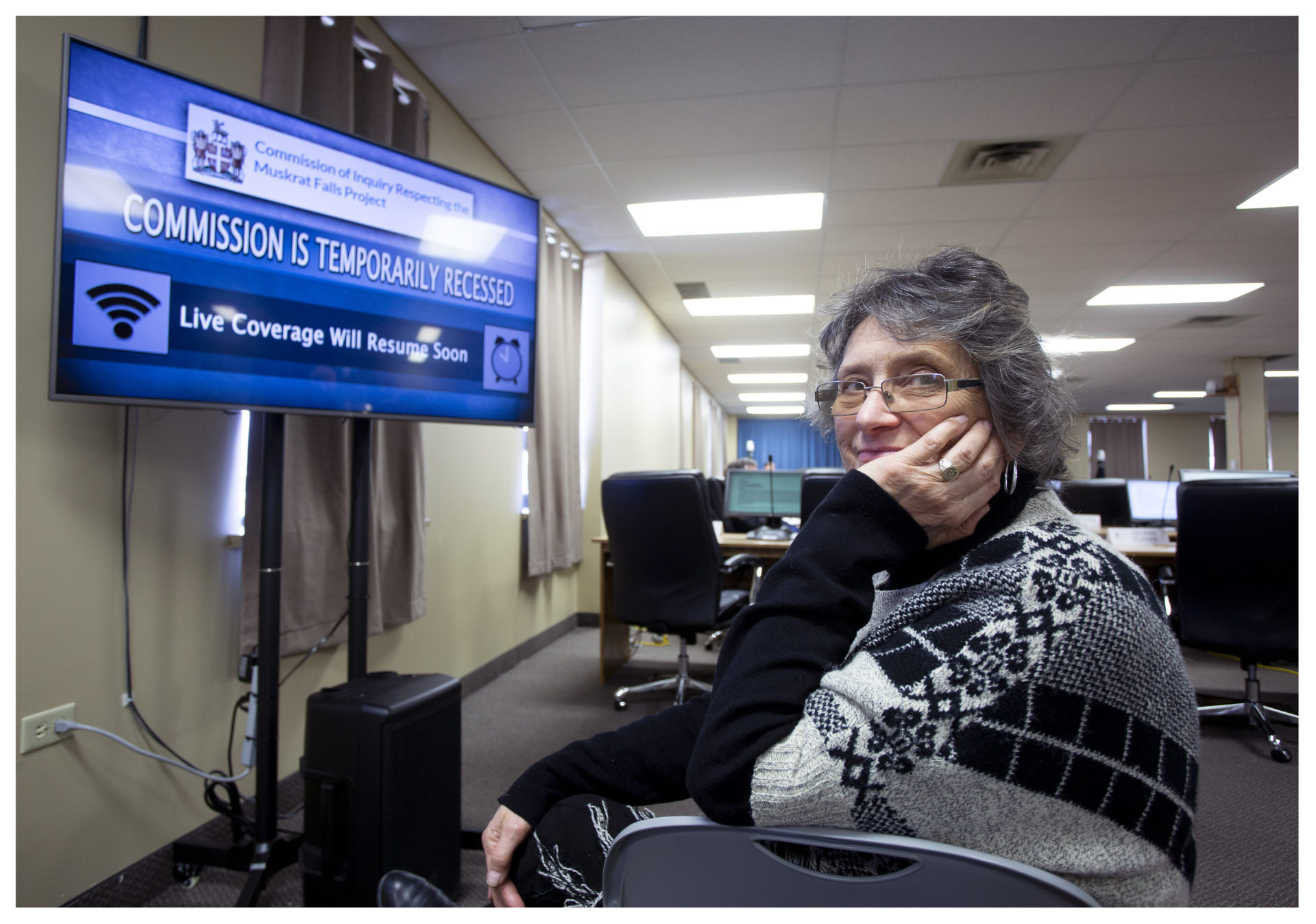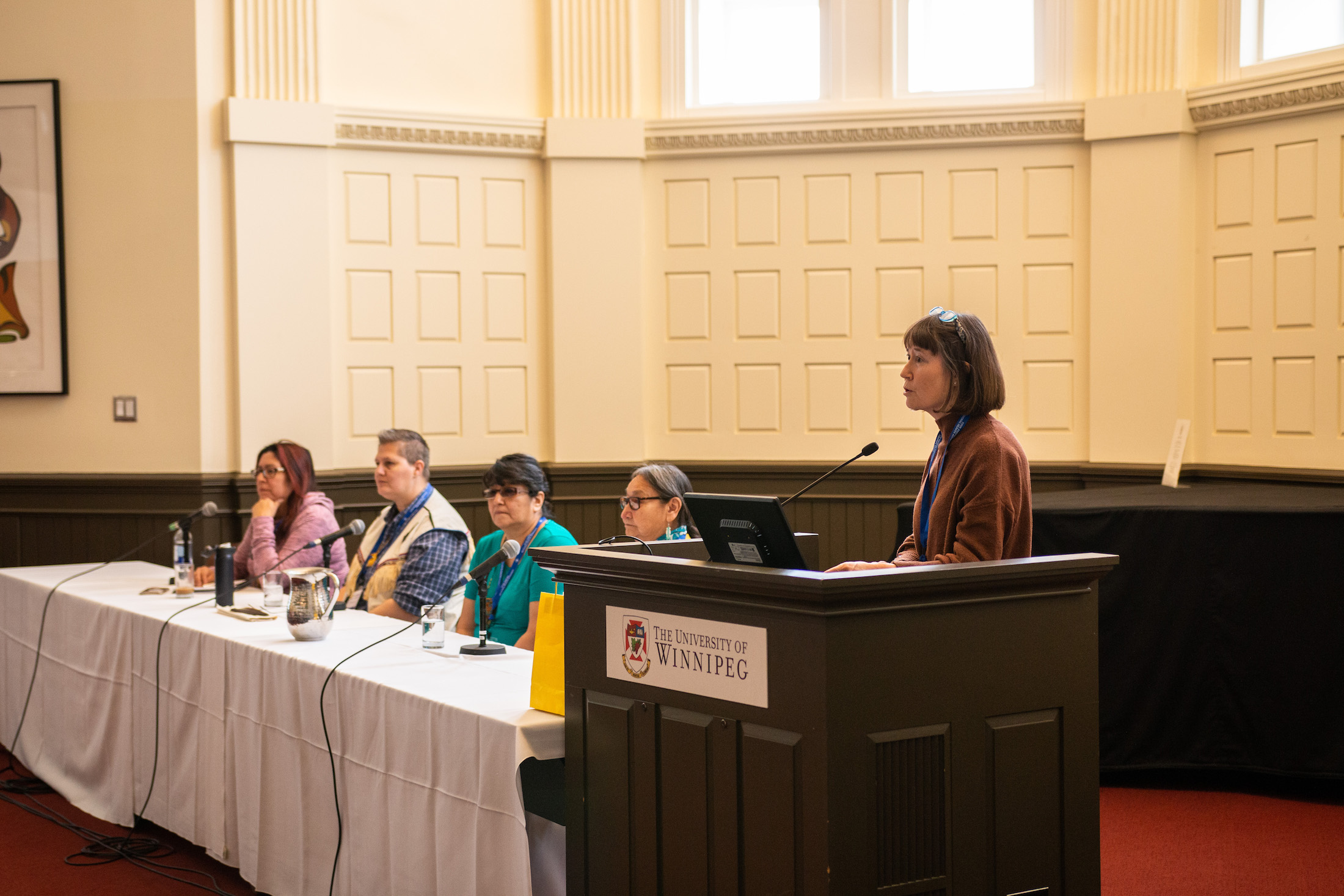
Hope for a huge, ancient and imperilled fish
First Nations are leading efforts to make sure lake sturgeon can find a home in...
Opposing a large hydro dam can be a lonely experience.
Just ask Roberta Frampton Benefiel, a long-time resident of the Labrador community of Happy Valley-Goose Bay, 36 kilometres from the boondoggle Muskrat Falls dam now nearing completion.
As a member of the Labrador Land Protectors, which brings together both Indigenous and non-Indigenous people, Benefiel now faces the possibility of yet another megadam on the Churchill River. If the proposed Gull Island dam is built, the Churchill “won’t be a river anymore,” she said in an interview with The Narwhal.
Yet when reached on the phone last week, Benefiel sounded positive — even optimistic — about the future of a growing global movement to stop the construction of destructive hydro dams.
She had just returned from a three-day conference in Winnipeg organized by Wa Ni Ska Tan
(a word that means “rise up” or “wake up” in Cree) to discuss the devastating impacts of large hydro projects across Canada and around the world.
The sold-out conference brought together about 300 people, many from communities impacted by projects like the Site C dam under construction in northeastern B.C., the Keeyask dam under construction in northern Manitoba and dams in the global south in countries including India, Panama, Brazil and Colombia.

Roberta Benefiel of the Labrador Land Protectors at the Muskrat Falls Public Inquiry in St. John’s, NL on Wednesday, March 27, 2019. Photo: Paul Daly / The Narwhal
“This was really where, as a riverkeeper in Canada fighting a dam, we needed to be,” said Benefiel, who is also a member of Grand Riverkeeper Labrador, a non-profit organization dedicated to protecting the Churchill River and its estuaries.
“Because we’re so far away and because we were just one Canadian dam group it just didn’t seem to work as well as it does with this Wa Ni Ska Tan group. Connecting with all the Canadian-affected communities was so important.”
Senator Mary Jane McCallum, who has advocated for the rights of hydro-impacted communities in Manitoba, said in a keynote address to the conference that she wants to launch a special investigation into the impacts of large Canadian hydro dams on Indigenous communities.
“You represent hope because you speak it and you walk it,” the senator told the crowd. “You’re intelligent, focused, witty and know when to break out into tears or laughter. That’s all good medicine. You are role models to me and I will carry this weekend to Senate with me to let me know that I’m not alone. And neither are you.”

Mary Jane McCallum speaking at the conference. Photo: Wa Ni Ska Tan
Such an experience was precisely what the conference’s organizers had hoped to foster.
In a post-conference call with The Narwhal, Wa Ni Ska Tan’s Ramona Neckoway and Stephane McLachlan said the three packed days of panel discussions and strategizing helped combine isolated struggles into a powerful international network.
Neckoway, who is from the hydro-impacted community of Nisichawayasihk Cree Nation in northern Manitoba, said photos of eastern Himalayan dams shown at the conference by political ecologist Deepa Joshi “are so familiar to me in terms of what we see, even though it was halfway around the world.”
McLachlan, coordinator of the University of Manitoba’s Environmental Conservation Lab, recalled other moments such as when a band councillor from Tataskweyak Cree Nation in northern Manitoba asked to get 50 copies of a strategy handout from a Brazilian dam opponent. In another instance, a fisherman from South Indian Lake showed a delegate from Panama a map of all the projects that Manitoba Hydro International (a controversial consulting subsidiary of the Crown corporation) has led in the Central American country.
Each instance represented a sharing of knowledge and experience among people who may have never met outside the conference, Neckoway and McLachlan noted.
On the last day of the conference Panamanian Jonathan González Quiel released a statement saying connecting with other hydro-impacted individuals and communities is critical.
“We used to be just a group of different rivers, but now we have converged to create a big ocean.”
It wasn’t all hopeful, however, with many moments of sorrow and frustration expressed throughout the conference.
The opening panel featured Indigenous people whose communities have been negatively affected by the Site C, Muskrat Falls and Keeyask dams.
Connie Greyeyes of Fort St. John, B.C., said resource projects, including the Site C dam, have increased the price of basic needs such as housing and food while the creation of man camps has compromised the safety of Indigenous women and girls.
Denise Cole of the Labrador Land Protectors spoke about the potential collapse of infrastructure for the Muskrat Falls dam that could flood the homes of 1,000 people, as well as the impending methylmercury contamination of fish, a traditional food source for local Indigenous people.
Members of Manitoba’s Tataskweyak Cree Nation talked about how their water has become dirty and contaminated since the advent of dam construction, which they said has brought with it significant social disorder, the abuse of drugs and alcohol, racial discrimination and the destruction of ancestral practices of hunting, trapping, fishing, and gathering. Burial sites, artifacts, and ancient trails have all been lost.
Robert Spence, a band councillor for the nation, broke down in tears while describing some of the impacts of the Keeyask dam and other large hydro projects.
“The water was supposed to be the answer to all of our people’s prayers,” he said to the room. “Whenever I hear the word ‘development’ I cringe. To me, it’s such a dirty word.”
Consultation and partnership agreements among the Crown corporations building the dams and impacted First Nations were also deeply criticized at the conference, with some dismissing these elements of the process as the equivalent of blackmail.
Spence described the effort to consult Indigenous communities and come to an agreement around benefits sharing as “a piggybank for lawyers and consultants.”
Cole added the reliance on consultation with a small number of “established leadership” can lead to project managers and bureaucrats ignoring community members.

Connie Greyeyes, pictured far left, said consultation around large-scale hydro projects can feel like bullying. Denise Cole, second from left, from the Labrador Land Protectors warned of a rise in methylmercury in the Muskrat Falls reservoir. Moderating the panel is The Narwhal’s B.C. legislative reporter Sarah Cox, pictured far right. Cox is the author of Breaching the Peace: The Site C Dam and a Valley’s Stand against Big Hydro. Photo: Wa Ni Ska Tan
“Our idea of consultation means that we have a meaningful consultation and come to an agreement that fits for everyone,” Greyeyes said.
“Not ‘here’s what we’re going to do, you’re going to like it and accept it and take this amount of money or you’re not going to get anything at all.’ ”
“That’s not consultation. That’s bullying. That’s the way it is.”
Two Treaty 8 First Nations in British Columbia — West Moberly First Nations and Prophet River First Nation — have filed civil actions alleging that the Site C dam, along with two previous dams on the Peace River, constitutes an unjustifiable infringement of their treaty rights.
A third Treaty 8 First Nation, Blueberry River First Nations, has launched legal action on the grounds that the cumulative impacts of industrial development in its traditional territory, including the Site C dam, infringes its treaty rights.
International activists brought stories of similar destruction and dispossession.
Deepa Joshi of Coventry University in the United Kingdom condemned the framing of hydroelectric power as a “climate solution” given its immense social and environmental impacts and greenhouse gas emissions from reservoirs.
She attributed the expansion of the “green economy agenda” in the global south to the post-2008 recession and desire for investors to find new profitable markets. That shift, Joshi said, was enabled in countries like India by reforms that made dam-building less financially risky and more profitable.
Latin American attendees of the conference also tied recent dam-building sprees to shifts in global political economy, with Elisa Estronioli of the Brazilian Movement of Communities Affected by Dams noting that Brazilians pay exceedingly high rates for electricity because the sector has been privatized.
Many hydro-affected communities in northern Manitoba also pay very high costs for power despite being most impacted by its development.
Manitoba’s hydro mess points to Canada’s larger problem with megadams
Quiel said the same corporations are building and financing these “projects of death” in Honduras, Nicaragua, Costa Rica, and Panama: “We have to expose and visualize who this enemy is that’s threatening our region,” he said through a translator.
KJ Joy of the India-based Society for Promoting Participative Ecosystem Management said a conservative estimate of people displaced in India due to development projects over the last half-century is 40 to 50 million, with hydropower projects one of the biggest factors in displacement.
The Report of the World Commission on Dams, published in 2000, estimated that between 40 to 80 million people have been displaced globally by large dams, including between 26 and 58 million in India and China between the years 1950 and 1990. China’s Three Gorges Dam, completed in 2006, displaced an estimated 1.2 million people and flooded 13 cities.
On a much smaller scale, the forced displacement of people is also occurring in B.C. with the construction of the Site C dam. The global human rights group Amnesty International says the Site C project does not meet international standards for forced evictions.
As with any event of such a scale, there wasn’t one specific takeaway or solution that conclusively set the way forward.
But many ideas emerged from a brainstorming session on the last day: class-action lawsuits against Crown corporations, engaging youth in hydro-impacted communities and helping them remember what life was like before the dams, improving public awareness with outreach and education campaigns, funding solar and wind power projects and introducing a moratorium on all new large dam projects while working to decommission existing ones.
Wa Ni Ska Tan organizers said the group will continue to strengthen international alliances, host more gatherings, and potentially work with McCallum on a special investigation into the impacts of large Canadian hydro projects on Indigenous communities.
Benefiel said one of the biggest issues her group faces in drawing public attention to the impacts of Muskrat Falls is a lack of funding, especially compared to publicly funded Crown corporations that don’t have to raise money for TV ads, media relations or lawsuits.

An ‘invoice’ tallying the costs of hydro development in the province of Manitoba as ‘incalculable’ is delivered to Manitoba Hydro. Photo: Wa Ni Ska Tan
“They can outdo us in the media, they can out-fund us,” she said. “We really need to pull together and show a very strong resistance across the country in order to provide that glue that would pull in some funding for us to do these things.”
That strong resistance was on full display at the end of the conference: a march through the freezing cold to the Manitoba Hydro building with banners, signs and chants led by Indigenous people from across Canada.
There, conference participants delivered an invoice to the Crown corporation for a litany of hydro-caused damages: destruction of waterways, a decline in fish populations, methylmercury contamination and loss of culture among them.
The total cost listed at the bottom of the invoice?
“Incalculable: too great to be calculated or estimated.”
Get the inside scoop on The Narwhal’s environment and climate reporting by signing up for our free newsletter. Angello Johnson’s shoulders burn, and his arms...
Continue reading
First Nations are leading efforts to make sure lake sturgeon can find a home in...

We’re excited to share that an investigation by The Narwhal is a finalist for the...

A new documentary, Nechako: It Will Be a Big River Again, dives into how two...
